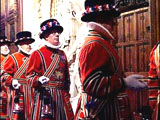
Customs and Traditions
by Mandy Barrow
|
Royal Ceremonies and Pageantry
|
|
London is a royal city and has preserved its ceremonies and traditions over hundreds of years. Some are every day and some are every year. The most traditional ceremonies and most popular attractions are the Trooping of the Colour and the Changing of the Guard. On this page you can read about:
Searching the Houses of Parliament. The State Opening of Parliament.
State openings usually take place in November, or soon after a General Election. On the day of the Opening, the Queen travels from Buckingham Palace to the Houses of Parliament in the Stage Coach (a gold carriage). Once the Queen arrives at Parliament the union flag is lowered and replaced by the royal standard. The Queen sits on a throne in the House of Lords and reads the "Queen's Speech". It is tradition for the monarch to open parliament in person, and The Queen has performed the ceremony in every year of her reign except for 1959 and 1963, when she was pregnant with princes Andrew and Edward respectively. No King or Queen has entered the House of Commons since 1642, when Charles l stormed in with his soldiers and tried to arrest five members of Parliament who were there. One of London’s most timeless ceremonies, dating back 700 years is the ceremony of the keys which takes place at the Tower of London. At 21:53 each night the Chief Yeoman Warder of the Tower, dressed in Tudor uniform, sets off to meet the Escort of the Key dressed in the well-known Beefeater uniform. Together they tour the various gates ceremonially locking them, on returning to the Bloody Tower archway they are challenged by a sentry.
A trumpeter then sounds the Last Post before the keys are secured in the Queen’s House.
Outside Buckingham Palace, you can see guardsmen dressed in their bright red uniforms and bearskin hats. These guardsmen protect the Queen. Every day a new guard of thirty guardsmen marches to the palace and takes the place of the "old guard". This is known as the Changing of the Guards ceremony and it dates back to 1660. Find out more and dates/times The monarch and the royal palaces have been guarded by the Household Troops since 1660.
On the River Thames there are hundred´s of swans and a lot of these beautiful white birds belong, traditionally, to the king or queen. In July, the Queen´s swan keeper sails up the River Thames, from London Bridge to Henley. He looks at all the young swans and marks the royal ones. For more information and photographs of Swan Upping click here This fairly new custom assures aspiring centenarians that they will receive a birthday telegram from the queen on their one-hundredth birthday.On his or her one hundreth birthday, a British person gets a telegram from the Queen. The Birthday Honours list and the New Year Honours list Twice a year at Buckingham Palace, the Queen gives titles or 'honours', once in January and once in June. Honours received include:
|
|
© Copyright Mandy Barrow 2013
Mandy is the creator of the Woodlands Resources section of the Woodlands Junior website.
The two websites projectbritain.com and primaryhomeworkhelp.co.uk are the new homes for the Woodlands Resources.
Mandy left Woodlands in 2003 to work in Kent schools as an ICT Consulatant.
She now teaches computers at The Granville School and St. John's Primary School in Sevenoaks Kent.
Woodlands Homework Help new website
customs traditions britain, scotland customs and traditions, traditional british christmas dinner, christmas customs traditions, christmas traditions, british culture customs traditions, british christmas customs, british christmas carols, british christmas crackers, british christmas pudding,british christmas trees, british christmas dinner, british celebrate christmas, british royal family, chrsitmas traditions, christmas customs, england, wales, scotland, Christmas Celebrations, british traditions, british customs, british culture, December, Christmas, food, christmas dinner, mince pies, advent, christmas eve, christmas day, boxing day, 12 days of christmas, new year, christmas pudding, christmas cake, christmas carols, christmas cards, christmas stocking, pantomime, santa claus, st nicholas, christmas presents, christmas crackers, christmas trees, mistletoe, holly, ivy
 Before every State Opening of
Before every State Opening of  Dating back to Medieval London, this ceremony marks the beginning of a new session of Parliament and allows the Government to announce its programme for that session. The ceremony features peers and bishops in traditional robes and a royal procession involving the State Coach.
Dating back to Medieval London, this ceremony marks the beginning of a new session of Parliament and allows the Government to announce its programme for that session. The ceremony features peers and bishops in traditional robes and a royal procession involving the State Coach.  The Queen, wearing her crown and ceremonial robes then processes through the Royal Gallery to take her place on the throne in the
The Queen, wearing her crown and ceremonial robes then processes through the Royal Gallery to take her place on the throne in the  Ceremony of the Keys
Ceremony of the Keys 
 ©
© 






